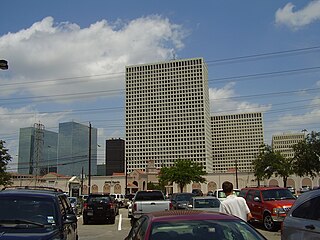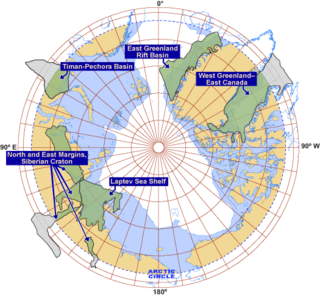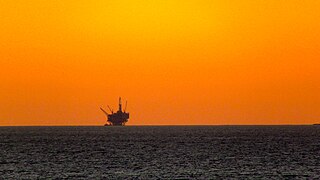Related Research Articles

An oil platform is a large structure with facilities to extract and process petroleum and natural gas that lie in rock formations beneath the seabed. Many oil platforms will also have facilities to accommodate the workers, although it is also common to have a separate accommodation platform linked by bridge to the production platform. Most commonly, oil platforms engage in activities on the continental shelf, though they can also be used in lakes, inshore waters, and inland seas. Depending on the circumstances, the platform may be fixed to the ocean floor, consist of an artificial island, or float. In some arrangements the main facility may have storage facilities for the processed oil. Remote subsea wells may also be connected to a platform by flow lines and by umbilical connections. These sub-sea facilities may include one or more subsea wells or manifold centres for multiple wells.

Offshore construction is the installation of structures and facilities in a marine environment, usually for the production and transmission of electricity, oil, gas and other resources. It is also called maritime engineering.

An oil well is a drillhole boring in Earth that is designed to bring petroleum oil hydrocarbons to the surface. Usually some natural gas is released as associated petroleum gas along with the oil. A well that is designed to produce only gas may be termed a gas well. Wells are created by drilling down into an oil or gas reserve and if necessary equipped with extraction devices such as pumpjacks. Creating the wells can be an expensive process, costing at least hundreds of thousands of dollars, and costing much more when in difficult-to-access locations, e.g., offshore. The process of modern drilling for wells first started in the 19th century but was made more efficient with advances to oil drilling rigs and technology during the 20th century.

North Sea oil is a mixture of hydrocarbons, comprising liquid petroleum and natural gas, produced from petroleum reservoirs beneath the North Sea.

Transocean Ltd. is an American drilling company. It is the world's largest offshore drilling contractor based on revenue and is based in Vernier, Switzerland. The company has offices in 20 countries, including Canada, the United States, Norway, United Kingdom, India, Brazil, Singapore, Indonesia, and Malaysia.

A blowout is the uncontrolled release of crude oil and/or natural gas from an oil well or gas well after pressure control systems have failed. Modern wells have blowout preventers intended to prevent such an occurrence. An accidental spark during a blowout can lead to a catastrophic oil or gas fire.
Sea Gem was the first British jack-up oil rig, known for its collapse off the coast of Lincolnshire on 27 December 1965, after two of its steel support legs buckled and the rig capsized, resulting in 13 fatalities.

Exploration for petroleum in the Arctic is expensive and challenging both technically and logistically. In the offshore, sea ice can be a major factor. There have been many discoveries of oil and gas in the several Arctic basins that have seen extensive exploration over past decades but distance from existing infrastructure has often deterred development. Development and production operations in the Arctic offshore as a result of exploration have been limited, with the exception of the Barents and Norwegian seas. In Alaska, exploration subsequent to the discovery of the Prudhoe Bay oilfield has focussed on the onshore and shallow coastal waters.

Offshore drilling is a mechanical process where a wellbore is drilled below the seabed. It is typically carried out in order to explore for and subsequently extract petroleum that lies in rock formations beneath the seabed. Most commonly, the term is used to describe drilling activities on the continental shelf, though the term can also be applied to drilling in lakes, inshore waters and inland seas.
Canada's early petroleum discoveries took place near population centres or along lines of penetration into the frontier.

A jackup rig or a self-elevating unit is a type of mobile platform that consists of a buoyant hull fitted with a number of movable legs, capable of raising its hull over the surface of the sea. The buoyant hull enables transportation of the unit and all attached machinery to a desired location. Once on location the hull is raised to the required elevation above the sea surface supported by the sea bed. The legs of such units may be designed to penetrate the sea bed, may be fitted with enlarged sections or footings, or may be attached to a bottom mat. Generally jackup rigs are not self-propelled and rely on tugs or heavy lift ships for transportation.

The Douglas Complex is a 54-metre (177 ft) high system of three linked platforms in the Irish Sea, 24 kilometres (15 mi) off the North Wales coast. The Douglas oil field was discovered in 1990, and production commenced in 1996. Now operated by Eni, the complex consists of the wellhead platform, which drills into the seabed, a processing platform, which separates oil, gas and water, and thirdly an accommodation platform, which is composed of living quarters for the crew. This accommodation module was formerly the Morecambe Flame jack-up drilling rig.

Deepwater drilling, or deep well drilling, is the process of creating holes in the Earth's crust using a drilling rig for oil extraction under the deep sea. There are approximately 3400 deepwater wells in the Gulf of Mexico with depths greater than 150 meters.

Offshore oil and gas in the Gulf of Mexico is a major source of oil and natural gas in the United States. The western and central Gulf of Mexico, which includes offshore Texas, Louisiana, Mississippi, and Alabama, is one of the major petroleum-producing areas of the United States. Oil production from US federal waters in the Gulf of Mexico reached an all-time annual high of 1.65 million barrels per day in 2017. Oil production is expected to continue the upward trend in 2018 and 2019, based on ten new oil fields which are planned to start production in those years. According to the Energy Information Administration, "Gulf of Mexico federal offshore oil production accounts for 15% of total U.S. crude oil production and federal offshore natural gas production in the Gulf accounts for 5% of total U.S. dry production."
Oseberg Øst is an offshore oil field in the North Sea, located east of Oseberg Oil Field. The field was developed with a fixed production, drilling and quarters (PDQ) facility and is operated by Statoil. The first stage phase processing is done at the Oseberg Øst platform. The second and third phase processing of oil is done at the Oseberg Field Center and it is then transported to Sture terminal in Norway through the Oseberg Transport System.
Oseberg South is an offshore oil field in the North Sea, located 115 kilometres (71 mi) from the coastline and 13 kilometres (8.1 mi) south of Oseberg oil field. Oseberg Sør was discovered in 1984. The field was developed with a fixed production, drilling and quarters (PDQ) facility and is operated by Statoil. The first stage phase processing is done at the Oseberg Øst platform. The second and third phase processing of oil is done at the Oseberg Field Center and it is then transported to Sture Terminal in Norway through the Oseberg Transport System. The development of the Oseberg Sør was approved in 1977. Recent updates include approval of J structure which started producing in November 2006 and Oseberg Sør G Sentral which has been developed in 2009.
North Drilling Company is an Iranian company specialized in drilling oil and gas wells and its services in all regions of Iran and world, to global customers. The company was privatized in June 2009. As of February 2010, Mehr Eghtesad, a quasi-government investment company, owned 20% of its shares on the Tehran Stock Exchange.

Vladimir Ignatyuk is a Russian icebreaking anchor handling tug supply vessel. She was built by Burrard-Yarrows Corporation in Canada in 1983 as Kalvik as part of an Arctic drilling system developed by BeauDril, the drilling subsidiary of Gulf Canada Resources. After the offshore oil exploration in the Beaufort Sea ended in the early 1990s, she was sold to the Canadian shipping company Fednav in 1997 and renamed Arctic Kalvik. In 2003, she was purchased by Murmansk Shipping Company and transferred to Russia.
Saltpond Oil Field is an oil field off the coast of Ghana. The field was discovered in 1970 by Signal-Amoco Consortium. The field is currently managed by the Saltpond Offshore Producing Company (SOPCL), Ghana's oldest producer of crude oil.
Single steel drilling caisson is a drill barge that was built for year-round oil exploration in shallow ice-covered waters in the Beaufort Sea. The unit, initially named SSDC and later shortened to SDC, was converted from an old oil tanker in the early 1980s. It has been used to drill a total of eight oil wells on both Canadian and U.S. continental shelves, the most recent in 2006.
References
- 1 2 "Rig Hits Natural Gas in North Sea". The Baltimore Sun . 1964-06-24. Archived from the original on November 7, 2012. Retrieved 2011-06-24.
- 1 2 Gemeinhardt, J. Peter; Focht, John A. Jr. "Theoretical and Observed Performance of Mobile Rig Footings on Clay". Second Offshore Technology Conference, Houston. Vol. 2. Preprints. pp. 549–558.
- ↑ "Skill, Hope, Work, Giant Rigs Behind Search for Gas, Oil On North Sea Bed". The Calgary Herald . 1966-07-29. Retrieved 2011-06-24.
- ↑ Ocean industry. Vol. 3. Gulf Pub. Co. 1968. p. 43.
- 1 2 3 "Empire Land Corp. v. United States". FindACase. 1979-08-02. Retrieved 2011-06-24.
- 1 2 3 "Universal Drilling Co. v. United States". FindACase. 1976-01-29. Retrieved 2011-06-24.
- 1 2 "Offshore Innovation. A History of Offshore Development" (PDF). American Bureau of Shipping . Retrieved 2011-06-24.
- ↑ "Universal Drilling Leasing Contract". The Wall Street Journal . 1959-11-25. Archived from the original on November 7, 2012. Retrieved 2011-06-24.
- ↑ Oceanology international. Vol. 2. Industrial Research. 1967. p. 30.
- ↑ "14 Men Trapped on Barge". Bonham Daily Favorite. UPI. 1961-10-03. Retrieved 2011-06-24.
- 1 2 Thatje, S.; Gerdes, D.; Rachor, E. (1999). "A seafloor crater in the German Bight and its effects on the benthos" (PDF). Helgoland Marine Research. 53. Springer: 36–44. doi: 10.1007/pl00012136 . ISSN 1438-3888 . Retrieved 2011-06-24.
- ↑ Judd, Alan G.; Hovland, Martin (2007). Seabed fluid flow: the impact of geology, biology and the marine environment. Cambridge University Press. p. 364. ISBN 978-0-521-81950-3.
- ↑ "The Story of North Sea Oil and Gas". Dukes Wood Oil Museum. Retrieved 2011-06-24.
- ↑ Veil, John A. (2006-10-19). Why Are Produced Water Discharge Standards Different throughout the World? (PDF). 13th Integrated Petroleum Environmental Consortium Conference. San Antonio . Retrieved 2011-06-24.
- ↑ Dallos, Robert E. (1964-06-25). "European-American Oil Consortium Strikes Possible Natural Gas Bonanza in North Sea". The Wall Street Journal . Archived from the original on November 7, 2012. Retrieved 2011-06-24.
- ↑ Petroleum. Vol. 30. L. Hill. 1967. p. 102.
- ↑ Petroleum press service. Vol. 34. London: Petroleum Press Bureau. 1967. p. 71.
- ↑ Barlow, Doug (1969). "Getting down to the job". Gibraltar Chronicle. Archived from the original on 26 July 2004. Retrieved 1 May 2019– via Minewarfare & Clearance Diving Officers' Association.
- ↑ "Background". Saltpond Offshore Producing Company. Archived from the original on 2011-05-26. Retrieved 2011-06-24.
- ↑ The petroleum economist. Vol. 46. London: Petroleum Press Bureau. 1979. p. 76.